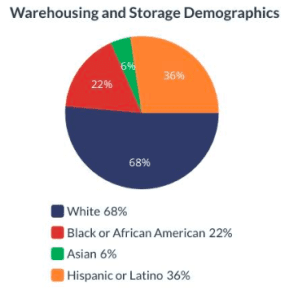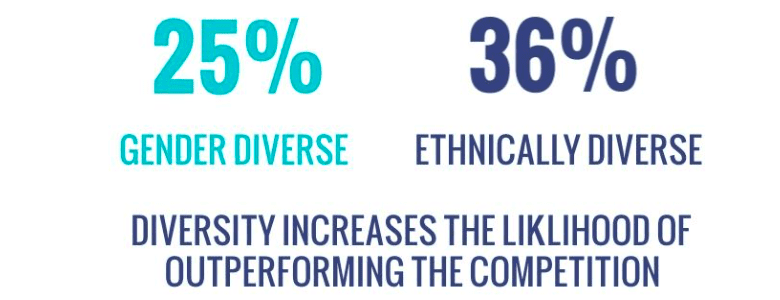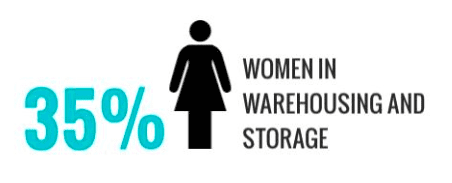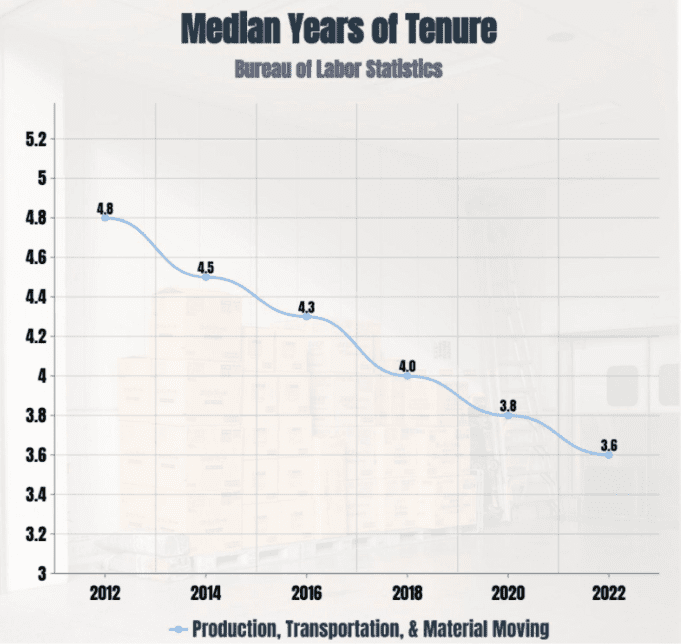It’s no secret the warehousing industry has been historically male-dominated. In recent years, however, a concerted effort has been made to increase diversity and inclusion in supply chain and warehouse roles. While this is undoubtedly a step in the right direction, there’s still more work to make the warehousing industry genuinely inclusive for everyone.
In this article, we’ll look at what diversity and inclusion mean in the context of warehousing, why it’s essential, and how warehouses can become more inclusive environments for all employees. Hopefully, by the end of this post, you’ll better understand how Diversity, Equity & Inclusion can positively impact warehousing.
Defining diversity and inclusion in the warehouse
Labor has been challenging for warehouses over the past few years. It has been difficult enough getting adequate labor, let alone focusing on diversity initiatives. Demographics from the Bureau of Labor Statistics (Figure 1) show the warehouse industry is predominantly white, followed by Hispanic or Latino. Implementing various measures can create an environment where everyone feels heard, respected, and accepted.

This can include providing tools and opportunities for employees to contribute their opinions and ideas, such as organizing regular team meetings, introducing effective communication channels, or allowing anonymous feedback. When warehouses can create this type of environment, they will attract and retain talent from many diverse backgrounds.
Promoting diversity and inclusivity at the workplace entails fostering a culture where different perspectives are welcomed, respected, and incorporated into day-to-day operations. To this end, employers should demonstrate equal treatment towards employees from diverse backgrounds or disabilities and take specific steps to address potential discrimination or exclusion issues. Finally, employers need to actively monitor the workplace environment to identify any problems which may arise and quickly address them with appropriate solutions. This is essential to create an atmosphere of trust, respect, and acceptance among the workforce so everyone can work together harmoniously.
Diversity and inclusion in the workplace are about respecting and valuing each other’s differences.
Creating an inclusive working environment to ensure everyone has the opportunity to voice their opinions, share ideas, and feel respected while also being able to express their true selves requires various measures. Such steps may include providing a platform for open communication and dialogue, encouraging diverse representation in decision-making processes, creating an equitable culture that values all perspectives, and actively listening and responding to any issues or conflicts that may arise.
Additionally, implementing training programs to promote awareness of unconscious bias can help foster an environment of greater understanding and acceptance. Employers should also ensure all staff members feel comfortable expressing their authentic selves without fear of discrimination or judgment.
The benefits of a diverse workforce
A diverse workforce is essential for any organization looking to leverage innovation and develop new ideas. Companies can create stimulating environments that encourage innovation and idea-sharing by utilizing a wide range of individuals within the workforce. Through a diversity of cultures, experiences, and backgrounds, organizations can benefit from different perspectives to support problem-solving in ways that may have previously been overlooked. According to research by McKinsey, companies shown to be gender and ethnically-diverse are more likely to outperform their peers by at least 25% financially (Figure 2).

Diversity also assists in understanding how different customer profiles respond to products, enabling firms to optimize their product offering and better understand their customer base. Further still, having access to information from multiple sources can help businesses make insightful decisions necessary for success. Ultimately, a comprehensive strategy of leveraging diversity within any workforce will enable enormous value creation internally and externally.
Diversity strengthens a workplace, helping to encourage creative problem-solving, innovative ideas, and the exchange of knowledge from various perspectives.
By creating an environment where respect is paramount, organizations can foster richer working experiences for their employees and gain greater insight into their markets.
Creating an inclusive environment in the warehouse
Creating an inclusive environment in the warehouse can play a significant role in fostering a healthy, collaborative workspace. Ensuring employees of all backgrounds feel valued and treated equitably is essential.
- Up-to-date research on best practices in diversity and inclusion should be made available to supervisors.
- Investing in training programs that teach ways to better approach issues rooted in identity will equip supervisors with the resources they need to cultivate a supportive warehouse environment.
Taking proactive steps to build a more inclusive workforce will not only empower individuals within your organization and will hopefully reduce the gender gap found in warehouses(Figure 3).

Still, it will also lend itself to creating an efficient operational structure that prioritizes success for employees of all backgrounds. Offering help and providing proper education are two components required for setting up an equitable system that embraces resilience and respect.
Tips for managers to promote diversity and inclusion
For modern managers looking to promote diversity and inclusion in the workplace, it is essential to listen to all voices, learn from one another and lean on experts as needed. The foundation of successful initiatives starts with a commitment to integrity and fairness. Managers should take the time to listen openly and support employees with diverse backgrounds, ideas, and beliefs. Demonstrating an authentic commitment to ensuring everyone is respected and included, a strong team bond will lead to better work outcomes for everyone.
A warehouse manager may be an expert in lean operations and an excellent all-around leader, but that doesn’t make them an expert in diversity and inclusion. Additional training and resources may be necessary to develop the diversity and inclusion skillsets required to lead through change. Utilizing the knowledge of experts in this field can help managers learn how to approach the topic with their teams, create effective policies and procedures, and assist in developing an overall environment of respect and acceptance.
Human Resources departments can also be instrumental in helping to create and maintain an inclusive warehouse. HR professionals should strive to create open communication channels between managers and employees, provide resources and training for managers, and develop a comprehensive diversity and inclusion strategy for the warehouse.
Although promoting diversity and inclusion may seem like an uphill battle, taking proactive steps to create an equitable work environment can have numerous long-term benefits. By investing in a comprehensive strategy, warehouses can benefit from a more diverse and accepting culture and enjoy increased productivity, creativity, and overall success. With the proper measures in place, every warehouse can make strides toward creating an inclusive workplace for all.
Employee Resource Groups and their role in promoting diversity
Employee Resource Groups (ERGs) are a powerful tool for businesses to promote diversity, foster collaboration, and grow their organization. ERGs bring together people of different backgrounds in the workplace by providing a platform through which they can offer mutual support, share information, and create a sense of belonging across all levels of the organization. They also amplify voices that might otherwise be forgotten or unheard and raise cultural awareness within the company.
Internal or external D&I experts can guide conversations and provide insights to help warehouses create an environment where it is safe to ask questions, learn from mistakes, and grow together.
Having these critical conversations and actively participating in diversity initiatives helps employees feel more included and improves morale, productivity, and job satisfaction. Greater diversity in an organization often leads to better innovation and growth opportunities due to its ability to create a more vibrant culture full of varied perspectives and ideas. As such, they are investing in employee resource groups is instrumental in improving the quality of work life for team members while broadening their business horizons.
The importance of training warehouse employees on diversity and inclusion
Whether you are onboarding new warehouse workers regularly or have a long-tenured staff, diversity and Inclusion training and education are essential to building a healthy workplace where everyone feels safe and welcome. According to the Bureau of Labor Statistics (Figure 4), the average tenure in warehouses has dropped steadily since 2012.

This means more onboarding of new warehouse workers, which should include diversity and inclusion training.
Training employees on diversity and inclusion is a fundamental part of fostering an inclusive culture in the workplace.
Next Steps
Providing comprehensive DE&I education for all company members shows a solid commitment to creating an open, respectful culture. DE&I programs include activities such as role-playing or simulations that can help enhance understanding of inclusion. Workplace diversity and inclusion are beneficial for businesses and employees alike.
Warehouse managers can create an inclusive environment by better understanding diversity and inclusion. Tips for promoting workplace diversity and inclusion include training employees on these topics, encouraging Employee Resource Groups, and openly communicating about inclusion initiatives.
What steps will you take to foster a diverse workforce in your warehouse?


